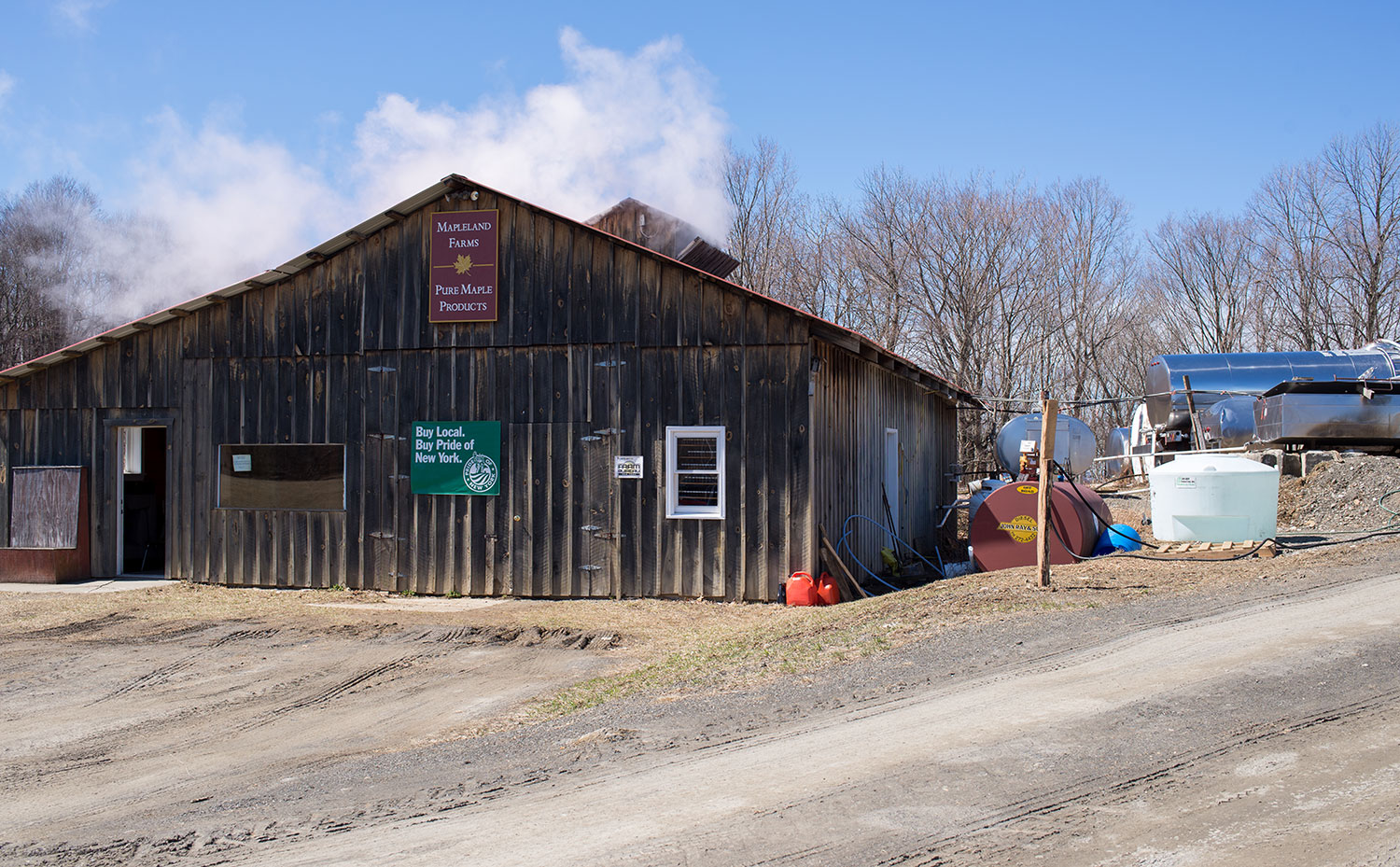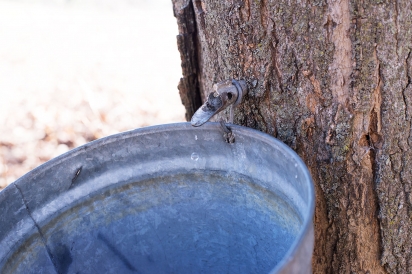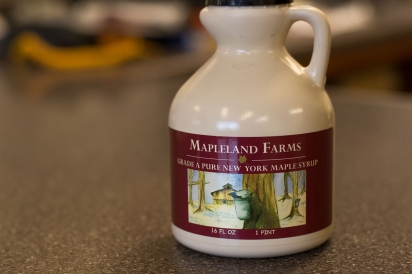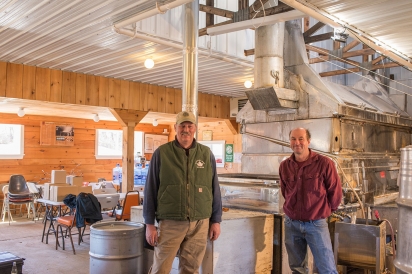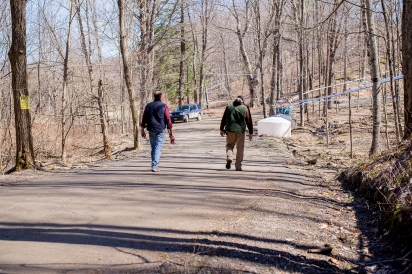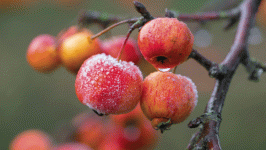A Sweet Life
David and Terry Campbell share a love of the land. The brothers have deep respect for a place that sustains them and the people they love.
On 350 acres of forested terrain in Argyle and Hebron, New York within Washington County stands Mapleland Farms’ 25,000 maple trees. As part of the largest family-run maple farm in the Upper Hudson Region, the Campbell brothers are stewards of a large swath of maple trees tapped using a vacuum system that depends on 75 miles of pressurized tubing. Lower atmospheric pressure on the outside of the tubing compared to the inside allows the sap to flow.
Owners Terry and David Campbell grew up on a dairy farm, tending cows. The pair looked forward to tapping select maple trees on the farm during sugaring season when they were kids. “We’d hustle the sap over to our grandfather’s sugarhouse for finishing,” says Terry.
“I guess we were trying to cut out the middle man when we asked our father for a loan to build a sap house on the farm,” jokes Terry. Their father, James, loaned them the money and together, the two boys, 11 and 12-years-old, built a sap house by themselves.
According to Terry, the best conditions to tap maple trees are freezing nights and daytime temperatures that thaw the frozen ground. Warm sunny days and frosty nights make for ideal conditions. The harvest season begins in January and ends with the first sign of spring when buds appear on trees.
What Terry misses about dairy farming–they sold their cows 12 years ago–is the routine it affords. “Sugaring is on Mother Nature’s schedule, not ours, and that’s unpredictable,” says Terry.
Sugaring starts with tapping the trees. When sap flows from a tree, it’s as crystal clear as water with a one to three percent sugar content. Concentrated sap is boiled down to a 67% syrup during an evaporation process. Mapleland Farms uses two reverse osmosis machines in their sap house to remove water and reduce the sap to an 18% sugar concentration. Minerals in the sap and its sugar content determine the color of the finished syrup. A standardized color system rates pure maple syrup. Darker syrups have stronger maple flavor.
As they expand their product line–a line that includes pure maple syrup, maple cream, maple fudge, maple candies, maple sugar and much more–the Campbells like to innovate. While Amber Pure Maple Syrup is a best seller, their bourbon barrel-aged pure maple syrup boasts a unique genesis.
“We met the owners of Lake George Distilling Company at a wine festival a few years ago. They were lamenting about not being able to reuse bourbon barrels they aged their bourbon in. Dave and I asked if we could have their used wet barrels to age our maple syrup. We put the barrels in cold storage, filled them with our highest quality dark maple syrup, and left it to age for four months. Chefs tell us our Bunker Hill Bourbon Barrel-Aged Maple Syrup makes great sauces and reductions,” says Terry.
Chefs at the Four Seasons Café in Saratoga Springs use Mapleland Farms pure maple syrup. So do the chefs at Tavern on the Green and Jean-Georges restaurant at Trump Tower in Manhattan, according to David, who operates the farm’s syrup bottling and candy-making facility on the farm. David’s two sons, one a lawyer and the other a pharmacist, both live near Manhattan. Both are getting married this year.
Whether it’s a restaurant in Asheville, North Carolina, a granola company in California, or a bed & breakfast in Rhode Island, Mapleland Farms ships anywhere there’s a demand for their products.
Even though the business is growing, Terry and David prefer to remain a family-owned and operated business. “We keep it small. Our families get along pretty well most of the time and when we don’t, we have 350 acres to get lost in until we’re ready to make up,” jokes Terry.
Terry and his wife, Sue, live in the oldest farmhouse on the property. Sue helps with internet sales, website management, and attends craft fairs. Every March, during New York State’s Maple Open House weekends, she prepares pancakes for 600 people a day. The annual open house includes a tour of the sugarbush and demonstration of the maple sugaring process.
Terry says the couple’s house has been in the family for years. “Our house is 200 years old. It belonged to my grandparents. The beams in the ceilings are still covered with bark from when they were dragged out of the woods,” says Terry.
“Our house sits on a ridge. If you look out my kitchen window, you’ll see the Adirondacks. If you look out the front window of the house, you’ll see the Green Mountains.”
Terry says the farm is in the town of Argyle, the new woodlot is in Hebron, and their mailbox just across the street is in Salem.
David and his wife, Mary Jeanne, live a quarter mile down the road. Mary Jeanne designs Mapleland Farms’ labels, coordinates marketing, and wholesale sales for the farm. Most days, there are two employees in the processing center making candies and preparing them for shipment. Three men in the woods help tap the trees, maintain pipelines, and assist with production at the sap house.
David, a year older than Terry, stays connected to other producers as Treasurer of the International Maple Syrup Institute; its membership includes producers and equipment manufacturers from across the U.S. and Canada.
“Being an officer of an international association gives me insight into the industry,” David says. He tracks market share of pure maple syrup. “Consumption is growing 10% a year. Maple syrup is considered the most nutritious sweetener available, full of minerals like calcium and potassium.” David is also past president of the New York State Maple Producers Association.
The sap house at Mapleland Farms, with its bright red roof and wood plank siding, is where the maple syrup processing takes place. It takes four maple trees each over 40 years old and six weeks of tapping to produce one gallon of maple syrup.
According to Terry, maple trees aren’t damaged by tapping. Only a small portion of a tree’s sap is taken. A hole is drilled and a stainless steel spout is inserted into the trunk. When the sugaring season is over, the taps are removed. Only a small scar remains where the spout was inserted.
“A scar heals in a year or two. We never tap a tree that’s less than eight inches in diameter. As trees get larger, we may insert more than one spout. Our parents taught us about sustainability and being part of the land,” notes Terry. “We are conscious of the land. If you’re working the land and you own it, there’s no point in abusing it,” says Terry. “It’s a satisfying feeling looking out onto this land and knowing that it’s yours to care for and to farm.”
David agrees. “An important part of my life is being connected to the land. I like the changing weather and being in the woods.”
Going into the woods every day can be solitary, but it’s a life neither brother would trade for anything in the world.


